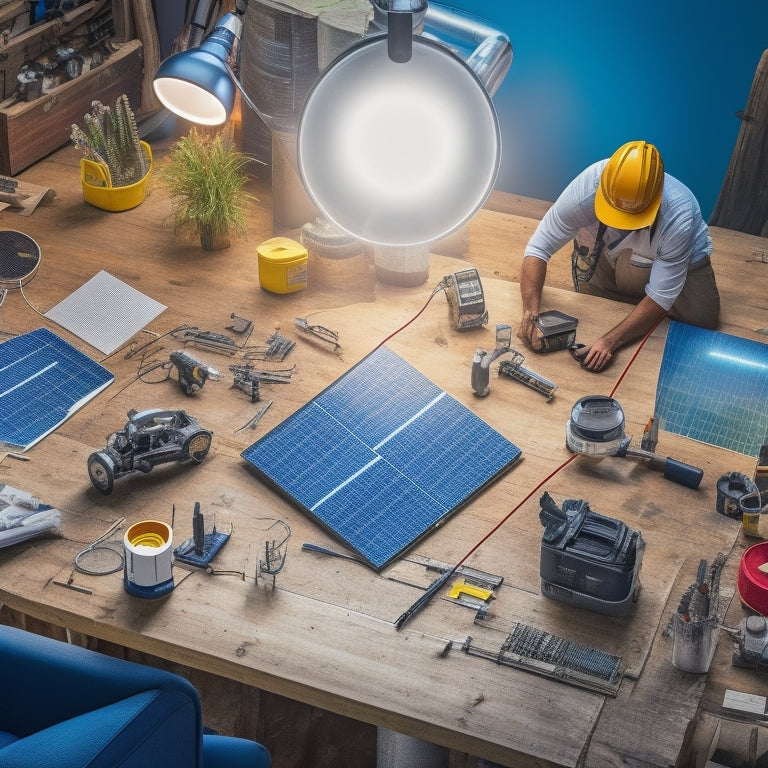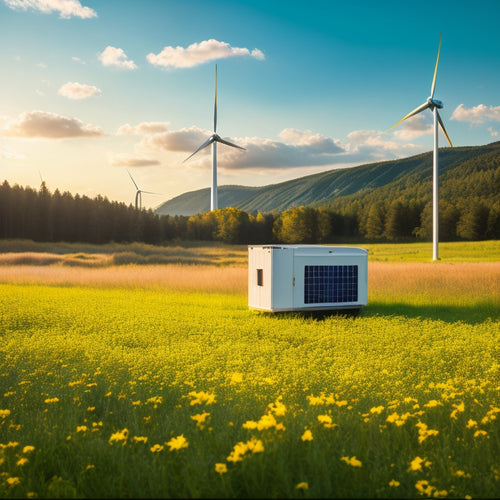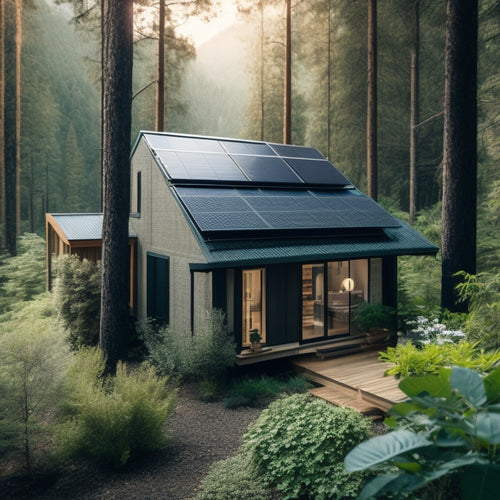
What to Check in Your DIY Energy System
Share
When you've invested in a DIY energy system, you're committed to generating clean power and reducing your reliance on the grid. To guarantee peak performance, safety, and efficiency, you need to regularly check and maintain seven critical components. Monitor solar panel performance metrics, battery health, and charge controller functionality. Verify inverter output and efficiency, and secure your mounting structure. Inspect electrical connections and wiring, and implement a reliable system monitoring and alert system. By doing so, you'll prevent performance issues, enhance safety, and maximize energy output - and understanding these complexities will reveal even more opportunities for enhancement.
Overview
- Monitor solar panel performance metrics, including irradiance, temperature, and cleaning schedules, to ensure optimal energy output.
- Regularly check battery health and state, including SOC, voltage, and temperature, to prevent overcharging and prolong lifespan.
- Verify charge controller functionality, including voltage regulation and overcharge protection, to maintain safe operating conditions.
- Ensure inverter output voltage and efficiency are within recommended ranges to prevent fluctuations and instability.
- Inspect mounting structure, electrical connections, and wiring regularly to prevent damage, overheating, and ensure overall system safety and efficiency.
Solar Panel Performance Metrics
Efficiency is key when it comes to utilizing the power of the sun.
You'll want to monitor your solar panel performance metrics to guarantee optimal energy production. Conduct a solar irradiance analysis to determine the amount of sunlight your panels receive. This data will help you identify areas for improvement.
Consider adjusting your panel orientation to maximize energy absorption, as proper angle and tilt adjustments can greatly increase energy output Optimize Panel Angle.
Regular cleaning can also improve energy output by up to 25%, so make certain to incorporate cleaning into your maintenance routine. Even slight adjustments can make a notable difference in energy output.
Additionally, track your panel's temperature, as high temperatures can reduce efficiency. By regularly monitoring these metrics, you'll be able to identify and address any issues, assuring your DIY energy system operates at its full potential.
Battery Health and State
Monitoring your battery health and state is essential to guarantee your DIY energy system's reliability and longevity. You should regularly check your battery's state of charge, voltage, and temperature to confirm they're within the manufacturer's recommended ranges.
Regular monitoring of battery state of charge (SOC) and depth of discharge (DOD) prevents overcharging and undercharging charge analysis. Implementing battery maintenance tips, such as equalizing your batteries and avoiding deep discharging, can help extend their lifespan.
Setting a discharge limit, typically between 20% and 50%, also extends solar battery lifespan and maintains health. Keep an eye out for battery replacement signs like excessive sulfation, corrosion, or water loss. If you notice any of these signs, it's time to replace your batteries to prevent system failure.
Charge Controller Functionality
You'll need to verify that your charge controller is functioning correctly by checking its voltage regulation, monitoring power flow, and testing overcharge protection.
These checks guarantee your system operates within a safe and efficient range. Start by examining the charge controller's voltage regulation to confirm it's keeping your batteries within the recommended voltage window.
Additionally, regular maintenance and cleaning of your solar panels every 6-12 months cleaning frequency can also optimize your system's performance, as dirty panels can reduce output by up to 25%.
Voltage Regulation Check
Frequently, DIY energy system installers overlook a critical component: the charge controller's voltage regulation functionality. This oversight can lead to voltage fluctuations, which can damage your system's components and compromise its overall performance.
You must guarantee your charge controller is regulating voltage effectively to maintain voltage stability. Check the controller's output voltage, comparing it to the recommended range for your system.
Verify the controller's ability to adjust voltage in response to changes in temperature, battery state of charge, and other environmental factors. A well-regulated voltage guarantees your system operates within a safe and efficient range, providing you with the freedom and independence you desire from your DIY energy system.
Power Flow Monitoring
With a well-regulated voltage in place, your DIY energy system is better equipped to handle the intricacies of power flow. Now, it's crucial to monitor power flow to verify your system operates efficiently. This involves tracking energy consumption and analyzing power flow patterns. A charge controller with built-in monitoring capabilities can simplify this process.
| Monitoring Aspect | Description |
|---|---|
| Real-time Power Flow | Displays instantaneous power output and input |
| Energy Consumption | Tracks total energy consumed over time |
| Power Flow Analysis | Provides observations into system performance and efficiency |
| Alert System | Notifies you of unusual power flow patterns or anomalies |
| Data Logging | Stores historical power flow data for future reference |
Overcharge Protection Test
Plug into your DIY energy system's charge controller to test its overcharge protection functionality, confirming your battery bank remains safe from damage.
You want to verify that the charge controller triggers an overcharge warning and prevents further charging when the batteries reach their maximum capacity. This prevents overheating, which can greatly reduce your battery lifespan.
Set your charge controller to simulate an overcharge scenario and observe its response. If it doesn't trigger the warning or cut off the charge, you may need to adjust the settings or replace the controller.
A functioning overcharge protection guarantees your energy system operates within a safe voltage range, safeguarding your investment and assuring a reliable power supply.
Inverter Output and Efficiency
You'll need to verify your inverter's output voltage levels match your system's requirements, whether it's 120/240 volts AC or another configuration.
Additionally, you'll want to confirm the inverter's ideal efficiency range, typically between 20% to 80% of its maximum capacity, to minimize energy losses.
During this process, be prepared to consult your inverter's documentation and specs to assure a seamless integration with your DIY energy system.
Output Voltage Levels
Your DIY energy system's inverter output voltage level directly impacts the efficiency and performance of your entire setup. Voltage fluctuations can lead to reduced output stability, affecting the reliability of your energy supply. It's essential to confirm your inverter output voltage falls within the recommended range.
| Voltage Level | Output Stability | Efficiency Impact |
|---|---|---|
| Within Spec (220-240V) | High | Ideal |
| Slightly Off Spec (210-250V) | Medium | Slightly Decreased |
| Far Off Spec (<210V or >250V) | Low | Considerably Decreased |
Verify your inverter output voltage regularly to prevent voltage fluctuations and maintain ideal efficiency.
Optimal Efficiency Range
Maintaining the ideal inverter output voltage is only half the battle; you must also guarantee it operates within the best efficiency range to maximize your DIY energy system's performance.
The best efficiency range is typically between 90% and 95%, ensuring minimal energy consumption and heat generation. Operating outside this range can lead to reduced system longevity and increased energy bills.
Check your inverter's specifications to determine its best efficiency range and adjust your system accordingly.
Monitor your inverter's efficiency regularly to identify potential issues before they affect your energy system's overall performance.
Mounting Structure and Security
The mounting structure's purpose is to securely fasten the DIY energy system's components to a roof, wall, or ground, protecting them from environmental elements and potential theft.
You'll want to guarantee the mounting materials you choose can withstand harsh weather conditions, such as heavy winds, rain, and extreme temperatures.
Assess the structural stability of your mounting structure by checking its sturdiness, rigidity, and ability to support the weight of the components.
Verify that the structure is securely anchored to the roof, wall, or ground to prevent it from shifting or toppling over.
A well-designed mounting structure will provide peace of mind, protecting your investment and assuring your DIY energy system operates safely and efficiently.
Electrical Connections and Wiring
With the mounting structure in place, you can now focus on guaranteeing the electrical connections and wiring are secure and efficient.
Check that all electrical connections meet wiring standards, and verify that they're properly insulated and protected from environmental factors. Take safety precautions seriously, guaranteeing that all connections are made with properly sized wires and that no wires are damaged or frayed.
Also, guarantee that all connections are securely fastened and won't come loose over time. Use wire ties or cable clamps to keep wires organized and secure.
System Monitoring and Alerts
Your DIY energy system's performance depends on reliable system monitoring and alerts. This guarantees you're always aware of your system's status, allowing you to address issues promptly and maintain ideal system reliability.
A well-designed user interface is essential for effective monitoring, providing you with clear, concise information about your system's performance. You should be able to easily track key metrics, such as energy production, consumption, and storage levels.
In addition, your system should be capable of sending alerts when issues arise, such as component failures or low battery levels. By having a strong monitoring and alert system in place, you can rest assured that your DIY energy system is running smoothly and efficiently, giving you the freedom and independence you desire.
Frequently Asked Questions
How Often Should I Clean My Solar Panels to Ensure Optimal Performance?
You should clean your solar panels every 6-12 months, depending on environmental factors, using gentle cleaning techniques to prevent scratches, and prioritize panel maintenance to guarantee ideal energy output and maximize your DIY energy independence.
What Is the Recommended Temperature Range for My DIY Energy System?
You'll want to verify your DIY energy system operates within the recommended temperature range of 59°F to 95°F (15°C to 35°C) for peak efficiency, so make certain to implement temperature monitoring and adjust as needed for efficiency optimization.
Can I Use My DIY Energy System During a Power Outage?
When the grid goes dark, you're not left in the cold - your DIY energy system can be your guiding light of freedom, providing backup power and energy independence, as long as you've properly configured it to function off-grid during outages.
How Do I Handle Snow or Ice Accumulation on My Solar Panels?
You'll need to prioritize snow removal and ice melting on your solar panels to maintain energy production; use a soft-bristled brush or specialized cleaning tools to gently remove snow, and consider installing a snow-melting system to guarantee peak energy harvesting.
Can I Expand My DIY Energy System in the Future if Needed?
Crafting a cleverly conceived energy ecosystem, you'll confidently capitalize on system scalability, effortlessly accommodating future upgrades as your power needs pivot, ensuring seamless integration and liberating you from reliance on external energy sources.
Ready to Buy
As you oversee your DIY energy system, remember that careful monitoring is essential. Neglecting these vital components can lead to system failure, safety hazards, and financial losses. By regularly checking solar panel performance, battery health, charge controller functionality, inverter output, mounting structure security, electrical connections, and system monitoring, you'll guarantee a reliable and efficient energy supply. Don't compromise your investment - stay vigilant and take control of your energy independence.
Related Posts
-

How to Achieve a Zero-Waste Lifestyle for a Greener Tomorrow
To achieve a zero-waste lifestyle, start by adopting the principles of refusing, reducing, reusing, and recycling. Sw...
-

Sustainable and Eco-Friendly Generators for a Reduced Carbon Footprint
Sustainable and eco-friendly generators are perfect for cutting your carbon footprint and increasing energy efficienc...
-

Off Grid Solar Batteries
As you shift to off-grid living, you'll rely on high-performance solar batteries to store excess energy generated by ...


